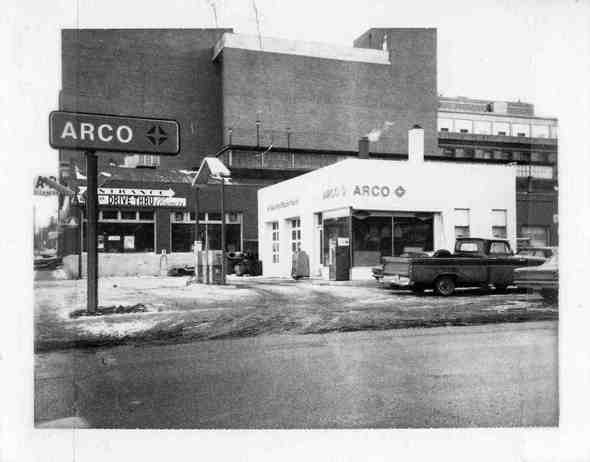Ann Arbor Historical Signs collection and the fight to keep the city beautiful

Roberts Service was located at the corner of Huron and Fifth Avenue. This 1971 photo from the Ann Arbor sign inspector documents some violation of the sign ordinance in effect at the time; the law was struck down in 1974 for being an "unreasonable exercise of police power," since it made almost every sign in town illegal.
Ann Arbor Historical Signs collection
About the collection
"Ann Arbor Historical Signs is a collection of photographs taken by the Ann Arbor Sign Inspector. Mostly taken in the 1970's, the collection gives a rich picture of the businesses and goings-on in Ann Arbor 35 years ago. This portrait of the city keeps growing as we continue to scan photographs from this collection, so be sure to check back and look for your old favorite haunts."
Why would there be a collection like this?
The usual reason for this sort of municipal photography is documentation to support enforcement of the law or collection of taxes.
The case Central Adv. Co. v. City of Ann Arbor, 218 NW 2d 27 - Mich: Supreme Court 1974, describes some of the history of the sign regulations leading up to this collection:
"City Council of defendant Ann Arbor adopted Chapter 61 of the Ann Arbor City Code (hereinafter designated the "sign ordinance") on December 12, 1966, effective ten days after its adoption. It was amended on March 4, 1968 and on May 20, 1968. Several challenges to the validity of the ordinance were subsequently commenced. After numerous legal maneuverings, the subject cases were tried simultaneously in the circuit court of Washtenaw County from July 6, 1970 through July 10, 1970. An opinion was filed on January 12, 1971 and judgments were filed on March 2, 1971, invalidating the sign ordinance ab initio. The opinion of the Court of Appeals was filed on July 24, 1972 upholding in part and reversing in part the judgments of the circuit court. Plaintiffs and defendant are both appellants and appellees, appealing those portions of the findings of the Court of Appeals which operated against their respective positions."
If you were the city sign inspector, trying to enforce a sign ordinance that was in the middle of litigation, you'd be carefully documenting the signs of the city. Here's some of the incidents that came up in that case:
"Individual citations for violations of the ordinance run the gamut. The owner of a small grocery store testified that he received a violation for displaying an "A-frame" type sign outside the store when open and, upon taking it in, he lost considerable money. A gasoline station owner testified that he received a violation for displaying a 3' high portable sign advertising oil, for a revolving sign advertising the gasoline brand, for a soft drink machine outside the station, for merchandise racks, for banners hung over the pumps, for an ice machine, for decals on the outside of doors, for a push-pull sign on the door and for discarded signs lying flat on the ground. A church was cited because its name was too large on a brick wall."
The court struck down the Ann Arbor sign law in this case, calling it an "unreasonable exercise of police power." If you look at this collection closely, it's likely that most of the signs documented here were in violation of local ordinance at the time that they were taken.
Billboard bandits of 1971
A Time Magazine story of March 22, 1971, describes The Billboard Caper, where youth took opposition to advertising signs into their own hands:
"In two weeks the Bandit's roaring chain saw sliced foot-thick support poles and toppled 35 offensive billboards along U.S. Highway 23. Where motorists once skimmed stirring legends like "Stuckey's Famous Pecans—2 Miles Ahead," they now have only trees and farmland to gaze upon.
Last week the crime was apparently solved, but not before four more billboards bit the dust along Interstate 96 north of Ann Arbor, Mich. Arrested by suspicious police, who spotted an ax and a saw in the back of their car, six Ann Arbor high school boys readily admitted that they were billboard bandits. All excellent students, the bandits include the president of the senior class at Huron High School, a member of the senior executive board, a member of the student council and a debater who most recently distinguished himself by his analysis of Government anti-pollution programs."
The carnage of highway billboards made national news, and this Sarasota Herald-Tribune article from April, 1971 has a photo of one of the downed billboards near Ann Arbor.
Edward Vielmetti studies the signs carefully for AnnArbor.com. Contact him at edwardvielmetti@annarbor.com.Â


Comments
Ben
Fri, Nov 5, 2010 : 11:47 p.m.
What a cool resource! I tried counting the name changes that have occurred to many of the buildings and businesses pictured, but kept running out of fingers. Then there are places like Mary's Fabulous Chicken & Fish that haven't changed a bit.